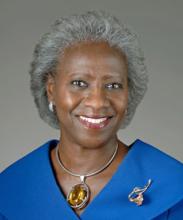
May, 2020
DR. VALANTINE'S FOOD FOR THOUGHT

Hannah A. Valantine, MD Chief Officer for Scientific Workforce Diversity
The COVID-19 (coronavirus disease 2019) pandemic has impacted our lives and the scientific workforce substantially. We are observing disproportionate effects in underserved populations leaving them particularly vulnerable to infection and mortality from COVID-19. Many of these vulnerable populations are also underrepresented in the science and medicine. Left unchecked, the detrimental effects of COVID-19 may harm recent gains made by enhancing diversifying of our scientific community. By prioritizing inclusive excellence, we can do our part to mitigate the pandemic's effects on the scientific workforce. This month we will explore a number of issues related to Diversity, Equity, and Inclusion (DEI) and COVID-19, as well as an action plan which offers useful advice for navigating DEI issues in these unprecedented times.
Vulnerable Populations and COVID-19
As the incidence and mortality rates of COVID-19 rises in the United States, the virus is shining a light on the health disparities among underserved and vulnerable groups. African Americans comprise a small part of the population, but a large percent of deaths in many states, along with Hispanics in New York City. The drivers of these disparities may include high population density in these communities and overrepresentation in frontline jobs that carry a high risk for COVID-19 (e.g. bus drivers, postal services, nursing care facility workers, and taxi drivers). Higher rates of comorbidities (e.g. Hypertension, Diabetes, etc.) in African Americans, Hispanics and Native Americans, compounded by disparities in the delivery of health care services, further exacerbate the risk of COVID-19 and dying from the disease. These troubling trends are also apparent for people with disabilities, care home residents, and those incarcerated, putting them among the vulnerable populations that are at higher risk becoming infected and dying from COVID-19. Aside from the devastating morbidity, mortality, and economic impacts of the COVID-19 pandemic, we are seeing biases emerge and reports of overt racism toward Asian Americans, creating a harmful culture of exclusion and “othering” that can have long-term effects on the diversity of our workforce and the connectedness of our society. To mitigate these issues, we need: rigorous tracking of COVID-related metrics by race and ethnicity, culturally sensitive messaging and policies, and a clear action plan for sustaining diversity and inclusion efforts.
Impact on Scientific Workforce Diversity
In the face of this pandemic, we are relying on biomedical researchers and clinicians to provide feasible public health solutions through innovation, rigor, and collaboration. These goals can only be achieved by leveraging the full extent of our diverse scientific workforce. However, COVID-19 threatens diversity and inclusion within our workforce in the several ways. First, underrepresented groups and women in the scientific workforce may disproportionately experience stress, trauma and setbacks, such as the loss of a family member or their own illness. Second, unchecked, a sustained reliance on “system 1”, biased thinking, will shift the organizational culture to be less inclusive. The power of organizational culture is such that this shift will trickle down to hiring activities, attitudes toward harassment and incivility, and scientific collaboration. Third, as travel restrictions persist, the loss of international trainees and students has wide-reaching and detrimental effects. Fourth, the impact of school and post-secondary institution closures on the next generation or early-stage biomedical researchers is undeniable. COVID-19 disruptions cause students to experience drastically different environments in the returning to their home lives. Moreover, a shift toward virtual education, can cause students who lack access to computers and broadband to fall through the cracks. These students more frequently have lower socioeconomic means and are disproportionately made up of individuals from underrepresented racial and ethnic groups. Finally, early-career scientists may be substantially impacted by COVID-19 disruptions as they face uncertainty and halts to research productivity at critical times in their careers (e.g. post-doc to faculty transition). If allowed to persist, these factors will lead to a less diverse scientific workforce, ultimately reducing our capacity for innovation and scholarly enterprise, as well as inhibiting our institutional mandate.
Standing Together: Addressing These Challenges
The NIH Scientific Workforce Diversity Office, in partnership with other NIH groups, is planning to move forward with targeted activities based on a framework of principles to help biomedical research institutions rapidly develop actions to ensure diversity and inclusion in the scientific workforce. Our action plan is guided by principles laid out in the COVID-19 DEI Crisis Action Framework which involve: highlighting COVID-19 as a diversity-related crisis, building evidence focused on COVID-19’s impacts to implement data-supported interventions for disproportionately affected scientific workforce groups, responding with elevated inclusive excellence, and addressing the strategic decision making process during this time. As we collectively navigate the COVID-19 crisis that is rapidly changing our environment, the scientific community should take decisive action to ensure the work on diversity and inclusion is sustained, and that we do not lose ground on recent progress. Above all, we must use inclusive language, messages, and policies in all responses to this ongoing crisis to prevent negative impacts on diversity, equity, and inclusion.

The links above are pulled from the top news articles trending on the subject of diversity in science and technology.
The stories selected are not a reflection of the views of the National Institutes of Health.

